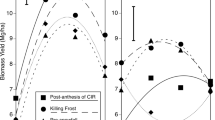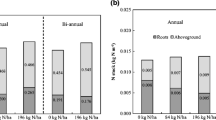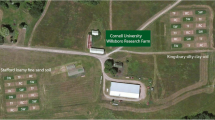Abstract
Field studies were conducted in 2000 and 2001 to examine yields and nutrient removal by Alamo switchgrass (Panicum virgatum L.) grown at eight locations within five states in the upper southeastern USA. Plots, which had been established for >5 years as part of a larger study, were cut either once (late fall) or twice (midsummer and late fall). Plots cut once received 50 kg N per hectare per year, while twice-cut plots received 100 kg N per hectare per year. Nutrient concentrations of and nutrient removal by harvested biomass were determined. Partitioning of nutrients into leaf and stem fractions was determined at the time of the midsummer harvest in 2000. Biomass production during 2000 and 2001 averaged 15.9 Mg/ha per year across all sites and was as high as 21.7 Mg/ha per year at one site. Two cuttings plus the additional 50 kg N per hectare did not generally increase seasonal yields; and, in one quite productive location, that management caused a yield reduction. Nitrogen removal with two cuts was much higher than with a single cut due largely to the higher N content in the midsummer harvest. Over the 2 years, twice as much N was removed with the two annual cuts as with one cut. Nitrogen removal exceeded the amounts of N applied in both managements, suggesting N was being supplied via mineralization or other processes. Phosphorus removal also increased significantly with the two-cut management. Seasonal K and Ca removals were more similar between the two managements. Nitrogen and P concentrations generally declined basipetally in tillers, with older leaves and internodes having lower concentrations of both nutrients. Potassium was more uniformly distributed than N throughout the tiller components (leaf and stem). Calcium was higher in older leaf blades. Levels of soil P, K, and Ca at most locations appeared not to be limiting biomass production and were adequate for long-term productivity.

Similar content being viewed by others
References
Parrish DJ, Fike JH (2005) The biology and agronomy of switchgrass for biofuels. Crit Rev Plant Sci 24:423–459
Lemus R, Brummer EC, Moore KJ, Molstad NE, Burras CL, Baker MF (2002) Biomass yield and quality of 20 switchgrass populations in southern Iowa, USA. Biomass Bioenergy 23:433–442
Hultquist SJ, Vogel KP, Lee DJ, Arumuganathan K, Kaeppler S (1996) Chloroplast DNA and nuclear DNA content variations among cultivars of switchgrass Panicum virgatum L. Crop Sci 36:1049–1052
Hopkins AA, Taliaferro CM, Murphy CD, Christian D (1996) Chromosome number and nuclear DNA content of several switchgrass populations. Crop Sci 36:1192–1195
Alderson J, Sharp WC (1995) Grass varieties in the United States. Lewis, Boca Raton, p 194
Obernberger I, Bierdermann F, Widmann W, Riedl R (1997) Concentration of inorganic elements in biomass fuels and recovery in the different ash fractions. Biomass Bioenergy 12(3):211–224. doi:10.1016/S0961-9534(696)00051-7
McLaughlin S, Button J, Bransby D, Conger R, Ocumpaugh W, Parrish D et al (1997) Evaluating and improving switchgrass as a bioenergy crop. In: Proceedings of the 3rd Biomass Conference of the Americas. August 24–29. Montreal, Quebec, Canada 1:137–143
Muir JP, Sanderson MA, Ocumpaugh WR, Jones RM, Reed RL (2001) Biomass production of ‘Alamo’ switchgrass in response to nitrogen, phosphorus, and row spacing. Agron J 93:896–901
Lemus R, Parrish D, Abaye O (2008) Nitrogen use-dynamics on switchgrass grown for biomass. Bioenergy Res 1:153–162. doi:10.1007/s12155-008-9014-x
Bredja JJ (2000) Fertilization of native warm-season grasses. In: Moore KJ, Anderson BE (eds) Native warm-season grasses: research trends and issues. CSSA and ASA, Madison, pp 177–200 CSSA Spec. Publ. 30
Mangaroo AS (1983) Soil fertility management for selected forages: the effect of nitrogen and phosphorous fertilization on the performance of improved forage cultivars. In: Forage Res: Texas CPR. Publ. 4141, pp 169–173
Fike JH, Parrish DJ, Wolf DD, Balasko JA, Green JT, Rasnake M et al (2006) Switchgrass production for the upper southeastern USA: influence of cultivar and cutting frequency on biomass yield. Biomass Bioenergy 30:207–213
Basta NT, Tabatabai MA (1985) Determination of total potassium, calcium, and magnesium in plant materials by ion chromatography. Soil Sci Soc Am J 49:76–81
Bremmer JM, Breitenbeck GA (1983) A simple method for determination of ammonium in semimicro-Kjeldahl analysis for soils and plant materials using a block digester. Commun Soil Sci Plant Anal 14:905–913
Donahue SJ, Heckendorn SE (1994) Soil test recommendations for Virginia. Virginia Coop. Ext. Serv., Virginia Tech, Blacksburg
Mehlich A (1953) Determination of P, Ca, Mg, K, Na, and NH4. North Carolina Soil Test Division
Parrish DJ, Wolf DD, Fike JH, Daniels WL (2002) Switchgrass as a biofuels crop for the upper southeast: variety trials and cultural improvements. Final Report for 1997 to 2001. Biofuels Feedstock Development Program. Oak Ridge National Laboratory, Oak Ridge, p 149
Littell RC, Henry PR, Ammerman CB (1997) Statistical analysis of repeated measures data using SAS procedures. J Anim Sci 76:1216–1231
SAS Institute Inc. (2008) SAS® user’s guide: statistics, v. 9.03. SAS Institute, Cary
Knapp AK (1985) Effect of fire and drought on the ecophysiology of Andropogon gerardii and Panicum virgatum in tall grass prairie. Ecology 66:1309–1320
Rao IM, Borrero V, Ricaurte J, Garcia R, Ayarza MA (1996) Adaptive attributes of tropical forage species to acid soils. II. Differences in shoot and root growth responses to varying phosphorus supply and soil type. J Plant Nut 19:323–352
White P (2001) The pathways of calcium movement in the xylem. J Exp Bot 52(358):891–899
Hart J, Christensen N, McReynolds R (2002) Potassium and production of perennial ryegrass for seed—Part 1. Oregon State University: Corvallis, OR. Crop Soil News/Notes 16(7):9–11
Sharpley AN, Daniels TC, Edwards DR (1993) Phosphorus movement in the landscape. J Prod Agric 6:492–500
Hue NV, Ikawa H, Huang X (1997) Predicting phosphorus requirements of some Hawaii soils. University of Hawaii at Manoa. Agronomy Soils AS-2:1–4
Brummer EC, Burras CL, Duffy MD, Moore KJ (2002) Switchgrass production in Iowa: economic analysis, soil suitability, and varietal performance. In: Annual Report. Bioenergy Feedstock Development Program, Oak Ridge National Laboratory, Oak Ridge, Tennessee, p 140
Fike JH, Parrish DJ, Alwang J, Cundiff JS (2007) Challenges for deploying dedicated, large-scale, bioenergy systems in the USA. CAB Reviews 2(064). doi:10.1079/PAVSNNR20072064
Parrish DJ, Fike JH, Bransby DI, Samson R (2008) Establishing and managing switchgrass as an energy crop. Forage and Grazinglands. doi:10.1094/FG-2008-0220-01-RV
US Department of Agriculture, Natural Resources Conservation Service (USDA-NRCS). Soil series name search. Online at: http://ortho.ftw.nrcs.usda.gov/cgi-bin/osd/osdnamequery.cgi. Accessed 9 January 2008
Acknowledgments
This research was funded in part by the US Department of Energy’s Bioenergy Feedstock Development Program at Oak Ridge National Laboratory. The authors thank John Balasko, Jim Green, Steve Hutton, W.T. Price, Monroe Rasnake, John Reynolds, and Dave Starner for their assistance with this project.
Author information
Authors and Affiliations
Corresponding author
Rights and permissions
About this article
Cite this article
Lemus, R., Parrish, D.J. & Wolf, D.D. Nutrient Uptake by ‘Alamo’ Switchgrass Used as an Energy Crop. Bioenerg. Res. 2, 37–50 (2009). https://doi.org/10.1007/s12155-009-9032-3
Received:
Accepted:
Published:
Issue Date:
DOI: https://doi.org/10.1007/s12155-009-9032-3




